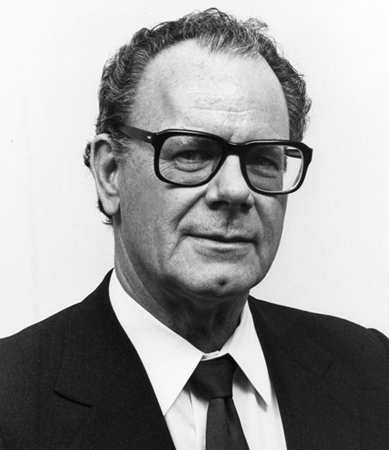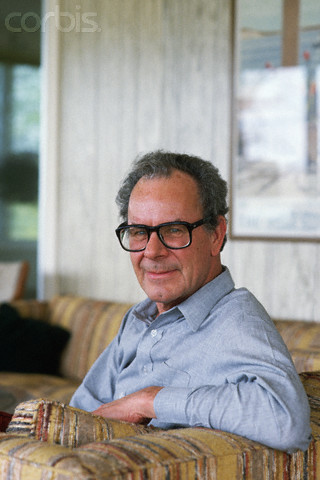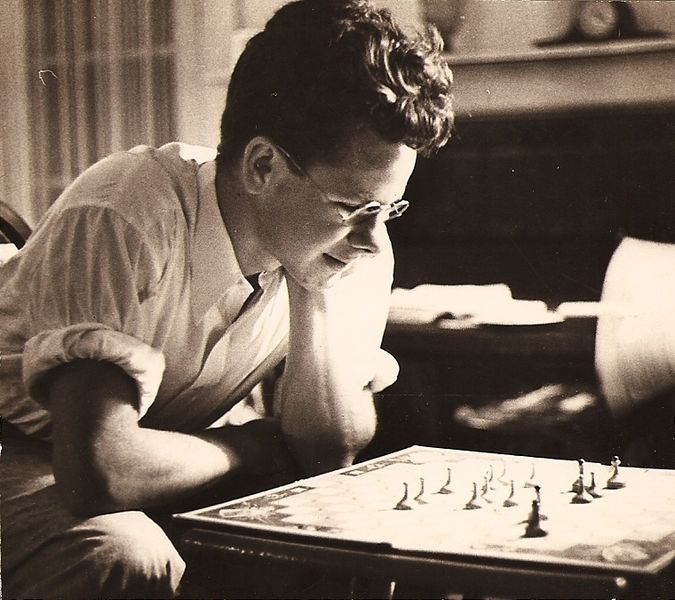<Back to Index>
- Physicist Gordon Gould, 1920
- Painter Hippolyte Delaroche, 1797
- 5th Vice President of the United States Elbridge Thomas Gerry, 1744
PAGE SPONSOR


Gordon Gould (July 17, 1920 – September 16, 2005) was an American physicist who is widely, but not universally, credited with the invention of the laser. Gould is best known for his thirty-year fight with the United States Patent and Trademark Office to obtain patents for the laser and related technologies. He also fought with laser manufacturers in court battles to enforce the patents he subsequently did obtain.
Born in New York City, Gould was the oldest of three sons. Both his parents were Methodists active in their community church, but he himself was an avowed atheist. His father was the founding editor of Scholastic Magazine Publications in New York City. He earned a Bachelor of Science degree in physics at Union College, where he became a member of the Sigma Chi Fraternity, and a Master's degree at Yale University, specializing in optics and spectroscopy. Between March 1944 and January 1945 he worked on the Manhattan Project but was dismissed due to his activities as a member of the Communist Political Association. In 1949 Gould went to Columbia University to work on a doctorate in optical and microwave spectroscopy. His doctoral supervisor was Nobel laureate Polykarp Kusch, who guided Gould to develop expertise in the then new technique of optical pumping. In 1956, Gould proposed using optical pumping to excite a maser, and discussed this idea with the maser's inventor Charles Townes, who was also a professor at Columbia and later won the 1964 Nobel prize for his work on the maser and the laser. Townes gave Gould advice on how to obtain a patent on his innovation, and agreed to act as a witness.
By 1957, many scientists including Townes were looking for a way to achieve maser like amplification of visible light. In November of that year, Gould realized that one could make an appropriate optical resonator by using two mirrors in the form of a Fabry-Pérot interferometer. Unlike previously considered designs, this approach would produce a narrow, coherent, intense beam. Since the sides of the cavity did not need to be reflective, the gain medium could easily be optically pumped to achieve the necessary population inversion. Gould also considered pumping of the medium by atomic level collisions, and anticipated many of the potential uses of such a device.
Gould recorded his analysis and suggested applications in a laboratory notebook under the heading "Some rough calculations on the feasibility of a LASER: Light Amplification by Stimulated Emission of Radiation" — the first recorded use of this acronym. Gould's notebook was the first written prescription for making a viable laser and, realizing what he had in hand, he took it to a neighborhood store to have his work notarized. Arthur Schawlow and Charles Townes independently discovered the importance of the Fabry-Pérot cavity — about three months later — and called the resulting proposed device an "optical maser". Gould's name for the device was first introduced to the public in a conference presentation in 1959, and was adopted despite resistance from Schawlow and his colleagues.
Eager
to achieve a patent on his invention, and believing incorrectly that he
needed to build a working laser to do this, Gould left Columbia without
completing his doctoral degree and joined a private research company,
TRG (Technical Research Group). He convinced his new employer to
support his research, and they obtained funding for the project from the Advanced Research Projects Agency, ironically with support from Charles Townes. Unfortunately for Gould, the government declared the project classified,
which meant that a security clearance was required to work on it.
Because of his former participation in communist activities, Gould was
unable to obtain a clearance. He continued to work at TRG, but was
unable to contribute directly to the project to realize his ideas. Due
to technical difficulties and perhaps Gould's inability to participate,
TRG was beaten in the race to build the first working laser by Theodore Maiman at Hughes Research Laboratories. During
this time, Gould and TRG began applying for patents on the technologies
Gould had developed. The first pair of applications, filed together in
April 1959, covered lasers based on Fabry-Pérot optical
resonators, as well as optical pumping, pumping by collisions in a gas discharge (as in helium-neon lasers), optical amplifiers, Q-switching, optical heterodyning, the use of Brewster's angle windows for polarization control, and applications including manufacturing, triggering chemical reactions, measuring distance, communications, and lidar. Schawlow and Townes also applied for a patent on the laser, which was
granted on March 22, 1960. Gould and TRG launched a legal challenge,
based on the precedence established by his notarized notebook from
1957. While this challenge was being fought in the Patent Office and
the courts, further applications were filed on specific laser
technologies by Bell Labs, Hughes Research Laboratories, Westinghouse, and others. Gould ultimately lost the battle for the U.S. patent on the
laser itself, primarily on the grounds that his notebook did not
explicitly say that the sidewalls of the laser medium were to be
transparent, even though he planned to optically pump the gain medium
through them, and considered loss of light through the sidewalls by diffraction. Questions
were also raised about whether Gould's notebook provided sufficient
information to allow a laser to be constructed, given that Gould's team
at TRG was unable to do so. Gould was able to obtain patents on the
laser in several other countries, however, and he continued fighting
for U.S. patents on specific laser technologies for many years
afterward. In 1967, Gould left TRG and joined the Polytechnic Institute of Brooklyn, now the Polytechnic University of New York,
as a professor. While there, he proposed many new laser applications,
and arranged government funding for laser research at the Institute. Gould's
first laser patent was awarded in 1968, covering an obscure
application — generating X-rays using a laser. The technology was of
little value, but the patent contained all the disclosures of his
original 1959 application, which had previously been secret. This
allowed the patent office greater leeway to reject patent applications
that conflicted with Gould's pending patents. Meanwhile
the patent hearings, court cases, and appeals on the most significant
patent applications continued, with many other inventors attempting to
claim precedence for various laser technologies. The question of just
how to assign credit for inventing the laser remains unresolved by
historians. By 1970, TRG had been bought by Control Data Corporation,
which had little interest in lasers and was disposing of that part of
the business. Gould was able to buy back his patent rights for a
thousand dollars, plus a small fraction of any future profits. In 1973, Gould left the Polytechnic Institute of Brooklyn to help found Optelecom, a company in Gaithersburg, Md, that makes fiberoptic communications equipment. He later left his successful company in 1985 because it was "boring." Shortly
after starting Optelecom, Gould and his lawyers changed the focus of
their patent battle. Having lost many court cases on the laser itself,
and running out of appeal options, they realized that many of the
difficulties could be avoided by focusing instead on the optical amplifier,
an essential component of any laser. The new strategy worked, and in
1977 Gould was awarded U.S. Patent 4,053,845, covering optically pumped
laser amplifiers. The laser industry, by then
grown to annual sales of around $400 million, rebelled at paying
royalties to license the technology they had been using for years, and
fought in court to avoid paying. The
industry outcry caused the patent office to stall on releasing Gould's
other pending patents, leading to more appeals and amendments to the
pending patents. Despite this, Gould was issued U.S. Patent 4,161,436 in 1979, covering a variety of laser applications including heating and vaporizing materials, welding, drilling, cutting, measuring distance, communication systems, television, laser photocopiers and other photochemical applications, and laser fusion.
The industry responded with lawsuits seeking to avoid paying to license
this patent as well. Also in 1979, Gould and his financial backers
founded the company Patlex, to hold the patent rights and handle
licensing and enforcement. The
legal battles continued, as the laser industry sought to not only
prevent the Patent Office from issuing Gould's remaining patents, but
also to have the already issued ones revoked. Gould and his company
were forced to fight both in court, and in Patent Office review
proceedings. According to Gould and his lawyers, the Office seemed
determined to prevent Gould from obtaining any more patents, and to
rescind the two that had been granted. Things finally began to change in 1985. After years of legal process, the Federal Court in Washington, DC, ordered the Patent Office to issue Gould's patent on collisionally pumped laser
amplifiers. The Patent Office appealed, but was ultimately forced to
issue U.S. Patent 4,704,583,
and to abandon its attempts to rescind Gould's previously issued
patents. The Brewster's angle window patent was later issued as U.S. Patent 4,746,201. The
end of the Patent Office action freed Gould's enforcement lawsuits to
proceed. Finally, in 1987, Patlex won its first decisive enforcement
victory, against Control Laser corporation, a manufacturer of lasers.
Rather than be bankrupted by the damages and the lack of a license to
the technology, the Board of Control Laser turned ownership of the
company over to Patlex in a settlement deal.
Other laser manufacturers and users quickly agreed to settle their
cases and take out licenses from Patlex on Patlex's terms. The
thirty year patent war that it took for Gould to win the rights to his
inventions became known as one of the most important patent battles in
history. In the end, Gould was issued forty-eight patents, with the
optical pumping, collisional pumping, and applications patents being
the most important. Between them, these technologies covered most lasers used at the time. For example, the first operating laser, a ruby laser, was optically pumped; the helium-neon laser is pumped by gas discharge. The
delay — and the subsequent spread of lasers into many areas of
technology — meant that the patents were much more valuable than if Gould
had won initially. Even though Gould had signed away eighty percent of
the proceeds in order to finance his court costs, he made several
million dollars. "I
thought that he legitimately had a right to the notion to making a
laser amplifier," said William R. Bennett, who was a member of the team
that built the first laser that could fire continuously. "He was able
to collect royalties from other people making lasers, including me." Even though his role in the actual invention of the laser was disputed over decades, Gould was elected to the National Inventors Hall of Fame in 1991. In
his acceptance speech he said, "I think it's important to be
self-critical. You have to weed out all of the aspects of an idea that
aren't going to work, or reject the entire idea in favor of some new
idea. You have to be encouraged to try things, even if they don't work." Gould died of natural causes on September 16, 2005. At the time of his death, Gould's role in the actual invention continued to be disputed in scientific circles. Apart from the dispute, Gould had realized his hope to "be around" when the Brewster's angle window patent expired in May 2005.
